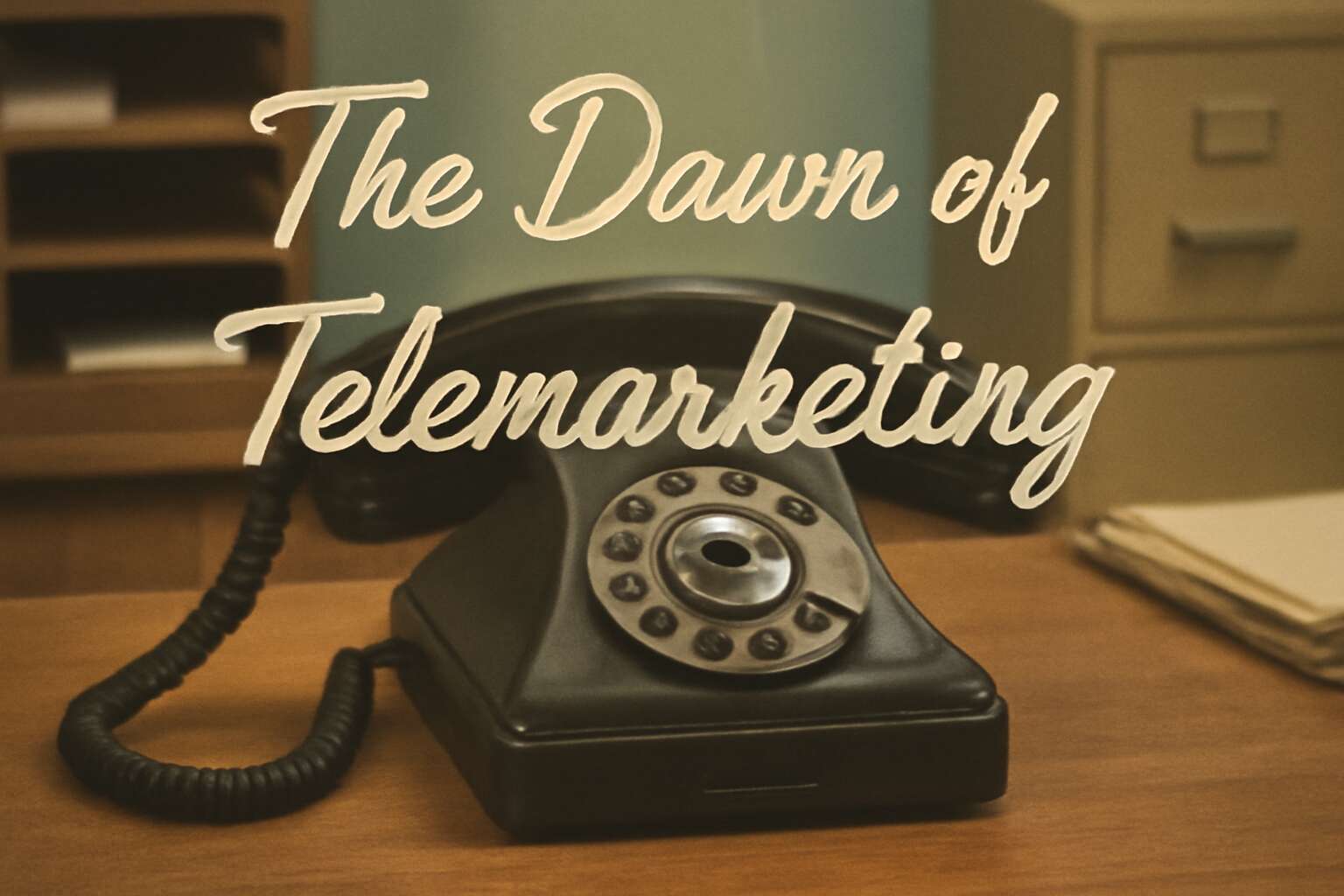Overview of Telemarketing
Definition of Telemarketing
Telemarketing, a term now synonymous with direct sales calls and customer outreach, has a rich history rooted in the evolution of communication technology. It’s fascinating to consider that the roots of telemarketing stretch back to the early days of telephone use, a device that transformed how people connected across distances. But when was telemarketing first used? The answer traces back to the 1950s, when businesses began to harness the telephone’s potential for direct marketing. This innovation allowed companies to reach potential clients more efficiently than traditional door-to-door sales or postal advertisements.
Initially, telemarketing was a straightforward approach—cold calling prospects, offering products or services, and gathering immediate feedback. The practice grew rapidly, especially in the United States, before spreading worldwide. Today, telemarketing is a sophisticated industry, but its humble beginnings remind us of the power of a simple phone call. Understanding when was telemarketing first used offers insight into how modern sales and marketing strategies continue to evolve, especially in markets like South Africa where personal connection remains vital.
Evolution of Telemarketing
The evolution of telemarketing is nothing short of a captivating journey through technological marvels and innovative sales strategies. From its humble beginnings in the 1950s, when businesses first harnessed the telephone’s power for direct outreach, telemarketing quickly transformed the landscape of sales and customer engagement. This era marked the dawn of a new era—one where a simple phone call could replace the traditional door-to-door approach, reaching prospects faster and with more precision.
As the decades unfurled, telemarketing evolved alongside advancements in communication technology. The introduction of automated dialers, sophisticated customer databases, and data analytics propelled the industry into a new realm of efficiency. Today, telemarketing is a carefully orchestrated blend of technology and human touch, vital for markets like South Africa, where personal connection remains key. Understanding when was telemarketing first used illuminates its remarkable transformation from basic cold calls to a complex, dynamic facet of modern marketing.
Historical Roots of Telemarketing
Early Forms of Direct Selling
In the shadowy corridors of commerce’s infancy, the roots of telemarketing stretch back further than most realize. While the modern conception of telemarketing might evoke images of cold calls and scripted pitches, its origins are intertwined with the age-old art of direct selling—an intimate dance of persuasion and trust. Historical records suggest that the earliest forms of direct selling, predating the telephone itself, relied heavily on face-to-face interactions and mailed catalogs, which laid the groundwork for more immediate methods of reaching consumers.
As technology evolved, so did the strategies of reaching potential customers. It was not until the late 19th century that the advent of the telephone began to transform direct selling. The question lingers: when was telemarketing first used? Precise timelines are elusive, yet the first documented instances of telephone-based sales date to the early 20th century, around the 1940s. During this period, businesses recognized the power of direct voice communication, harnessing it to cultivate a sense of immediacy and personal connection that was previously unattainable through traditional mail or door-to-door sales.
- Telephone sales campaigns targeting specific demographics gained momentum in the post-war era.
- Innovative marketing firms experimented with scripts and call schedules, laying the foundation for future telemarketing practices.
Thus, the origins of telemarketing are rooted in a complex evolution—a fusion of emerging technology and the timeless human desire for connection. It’s a testament to how a simple device like the telephone revolutionized the art of persuasion, making the question of when was telemarketing first used not just a matter of dates, but a reflection of society’s relentless pursuit of more immediate and personalized marketing channels.
Precursor Technologies and Methods
Long before the ringing of telephones became a ubiquitous symphony in households and boardrooms alike, the seeds of telemarketing were sown in the fertile soil of precursor technologies and methods. These early endeavors in direct communication bore the whisper of future innovations, subtly shaping the landscape of modern marketing. The telegraph, with its flickering signals across vast distances, was a vital precursor—an invisible thread woven into the tapestry of communication history. It demonstrated the profound power of instant connectivity, setting the stage for what was to come.
In the realm of telemarketing’s origins, it is essential to recognize the significance of these foundational tools. As businesses sought more immediate ways to connect with potential customers, they turned to innovations like the telegraph and mailed catalogs—each a stepping stone in the evolution of direct selling. These methods, though primitive by today’s standards, embodied the timeless human desire for personal engagement and persuasion.
- The advent of the telephone in the late 19th century marked a turning point, transforming distant whispers into clear, direct conversations. This new technology ignited a wave of experimentation, leading to the first documented instances of telephone-based sales around the 1940s.
- During this period, marketing firms began to explore the art of scripting calls and scheduling outreach, laying the groundwork for the intricate dance of modern telemarketing practices.
It’s a captivating thought—how each technological leap, from the telegraph to the telephone, contributed to the complex mosaic of telemarketing’s history. The question of when was telemarketing first used is not simply a matter of dates; it is a reflection of society’s relentless pursuit of more immediate, personal, and compelling communication channels. In South Africa and beyond, this evolution continues to shape the way businesses connect with their audiences, blending innovation with the age-old craft of persuasion.
Pioneering Developments in Telecommunication
Invention of the Telephone
The birth of telecommunication revolutionized human interaction, laying the groundwork for what would become telemarketing. The invention of the telephone by Alexander Graham Bell in 1876 marked a pivotal moment in history, but it wasn’t until decades later that the technology found its commercial purpose. The question of when was telemarketing first used often leads back to the early 20th century, a period brimming with innovation and societal shifts. Telephones, initially a novelty, soon became essential tools for business communication, creating a fertile ground for direct marketing efforts.
By the 1940s and 1950s, companies began experimenting with using the telephone for sales and customer outreach, transforming the passive act of calling into a dynamic method of engagement. This era saw the emergence of dedicated telemarketing teams, whose purpose was to foster personal connections in a way that mail or print advertisements couldn’t match. The evolution of telecommunication infrastructure—along with advancements like automatic dialers—solidified telemarketing’s role as a vital marketing strategy.
- Invention of the telephone (1876)
- Early commercial applications in the 1940s
- Formalization of telemarketing practices in the 1950s
Understanding when was telemarketing first used is not just about tracing technological milestones; it’s about appreciating how communication channels shape social and economic landscapes. The shift from mere invention to strategic application reveals a fascinating narrative of innovation, adaptation, and human connection—elements that continue to define telemarketing today.
Impact on Business Communication
The advent of pioneering developments in telecommunication revolutionized the way businesses connect with their audiences. As the telephone’s reach expanded, so did its potential to transform marketing strategies. The question of when was telemarketing first used often sparks curiosity, but the real breakthrough came when companies recognized the telephone’s power for direct engagement. It wasn’t just about making calls; it was about creating a new realm of personal interaction that could influence purchasing decisions in real-time.
By the 1940s, businesses were experimenting with using the telephone as a sales tool, setting the stage for what would become telemarketing. The industrial boom and societal shifts demanded faster, more efficient communication channels—telephones fit perfectly into this niche. The impact was profound: companies could now reach potential customers instantly, fostering relationships that print ads simply couldn’t achieve. The evolution of telecommunication infrastructure, coupled with innovations like automatic dialers, accelerated this process and solidified telemarketing’s role in modern business communication.
First Known Uses of Telemarketing
Early 20th Century Experiments
In the shadowy corridors of commercial history, the question lingers: when was telemarketing first used? It’s a query that beckons us into a realm where innovation and curiosity intertwine like spectral threads. The earliest experiments in telemarketing emerged during the early 20th century, a time when the telephone’s ghostly whisper was just beginning to echo through the corridors of business. These fledgling ventures, cloaked in the fog of technological infancy, sought to harness the power of the telephone to forge new pathways of direct selling.
By the 1930s, some pioneering companies had begun to leverage this nascent technology for outreach, transforming it into a tool for persuasive communication. An intriguing chapter unfolds as telemarketing evolved from simple voice contact to a more strategic form of customer engagement. It was during this period that the true potential of telephone-based marketing started to emerge, setting the stage for a future where cold calls would become a haunting yet essential part of the commercial landscape.
Key Milestones in Telemarketing History
As the dawn of modern commerce cast its long shadow over the 20th century, the question of when was telemarketing first used becomes a tantalizing mystery, shrouded in the mists of innovation. The earliest key milestones in telemarketing history reveal a fascinating evolution—a dance between technology and persuasion that continues to shape our world today. By the 1940s, companies began experimenting with the telephone as a tool for direct customer engagement, transforming the once simple device into a conduit for strategic outreach.
In fact, the first known uses of telemarketing can be traced to a handful of pioneering firms who recognized its potential for sales and lead generation. These early ventures laid the groundwork for what would become a vital component of global business communication. Interestingly, the development of this field was marked by a series of milestones, including:
- The advent of automated dialing systems in the 1960s, which exponentially increased call volume and efficiency.
- The rise of dedicated telemarketing agencies in the 1970s, turning the craft into a specialized industry.
- Legislative changes in the 1990s that regulated cold calling practices, shaping the ethical landscape of telemarketing.
Such milestones highlight the persistent march of telemarketing’s history—a story of relentless innovation that prompts us to ask: when was telemarketing first used? It’s a question that continues to echo through the corridors of commercial history, reminding us of the power of voice and connection in shaping the future of business.
Legal and Regulatory Milestones
Introduction of Telemarketing Regulations
Legal and regulatory milestones have played a crucial role in shaping the landscape of telemarketing. As this direct marketing approach grew in popularity, governments around the world recognized the need to protect consumers from intrusive or deceptive practices. In South Africa, the introduction of telemarketing regulations marked a turning point in establishing clear boundaries for businesses. These regulations aimed to balance commercial interests with consumer rights, ensuring fair and transparent communication.
When was telemarketing first used? While the practice dates back to the mid-20th century, it wasn’t until the advent of formal legislation that it truly evolved into a regulated industry. For example, in the early 2000s, many countries introduced do-not-call lists and strict opt-out policies. These legal frameworks aimed to curb unwanted calls and foster trust in telemarketing. The South African Consumer Protection Act and related regulations exemplify this shift, highlighting the importance of legal milestones in safeguarding consumers and maintaining ethical standards in telemarketing practices.
Impact of Laws on Telemarketing Practices
The precise moment when was telemarketing first used remains elusive, but its roots stretch back to the mid-20th century when businesses began experimenting with direct outreach methods. As the telephone became more widespread, companies saw an unprecedented opportunity to connect with potential customers instantaneously. This era marked a turning point—transforming the landscape of marketing from passive advertising to active engagement.
However, it wasn’t until the dawn of formal legislation that telemarketing truly matured into a regulated industry. Governments worldwide recognized the need to strike a balance between commercial interests and consumer rights. In South Africa, the introduction of telemarketing regulations signaled a pivotal shift. These laws established boundaries that aimed to curb intrusive calls, protect vulnerable consumers, and promote ethical marketing practices.
Impact of laws on telemarketing practices can be profound. For instance, the implementation of do-not-call lists and strict opt-out policies created a framework that fostered trust and transparency. These legal milestones helped shape an industry that is responsive to societal expectations, ensuring that when was telemarketing first used is now complemented by a clear understanding of how it should operate within ethical boundaries.
Modern Telemarketing and Its Origins
Transition from Cold Calling to Digital Marketing
In shadows cast long before the dawn of modern marketing, the seed of telemarketing was quietly sown with the invention of the telephone. It was as if a whisper from the abyss, promising new avenues for commerce—an eerie portal into the human psyche. When was telemarketing first used? Historical whispers suggest it emerged in the early 20th century, as businesses sought to harness this spectral device to summon customers from the void.
Transitioning from cold calling’s ghostly echoes, telemarketing evolved into a more sinister art form—melding human intuition with the cold precision of digital marketing. Today, the landscape is haunted by automated scripts and data-driven campaigns, yet beneath this veneer lies the same primal urge to connect, manipulate, and persuade. As technology advanced, so did the reach of telemarketing, morphing into a digital specter that haunts the modern consumer—an eternal dance between the tangible and the intangible.
Current Trends in Telemarketing
In the dim corridors of commerce’s past, telemarketing’s roots shimmer like faintly glowing embers—waiting to spark into a roaring flame. Today, it’s hard to imagine a world without the telephonic charm that once revolutionized outreach. But when was telemarketing first used? Historical whispers suggest it emerged quietly in the early 20th century, as savvy entrepreneurs harnessed the invention of the telephone to reach customers directly. This clandestine art soon grew into a powerful tool, blending human intuition with technological innovation.
Modern telemarketing has transformed into an intricate dance of data-driven precision and personalized engagement. Current trends reveal a shift towards predictive analytics and AI-powered scripts, making interactions more tailored and efficient. As the digital age pushes boundaries further, telemarketing continues to adapt, often blurring the lines between persuasion and automation. It’s a compelling evolution—one that still carries the primal urge to connect, persuade, and influence.
- Automated voice campaigns
- Personalized outreach through CRM systems
- Integration with social media platforms
Each trend rewrites the narrative of when was telemarketing first used, showing how far this mystical form of communication has come from its humble beginnings to its current digital frontier.




0 Comments